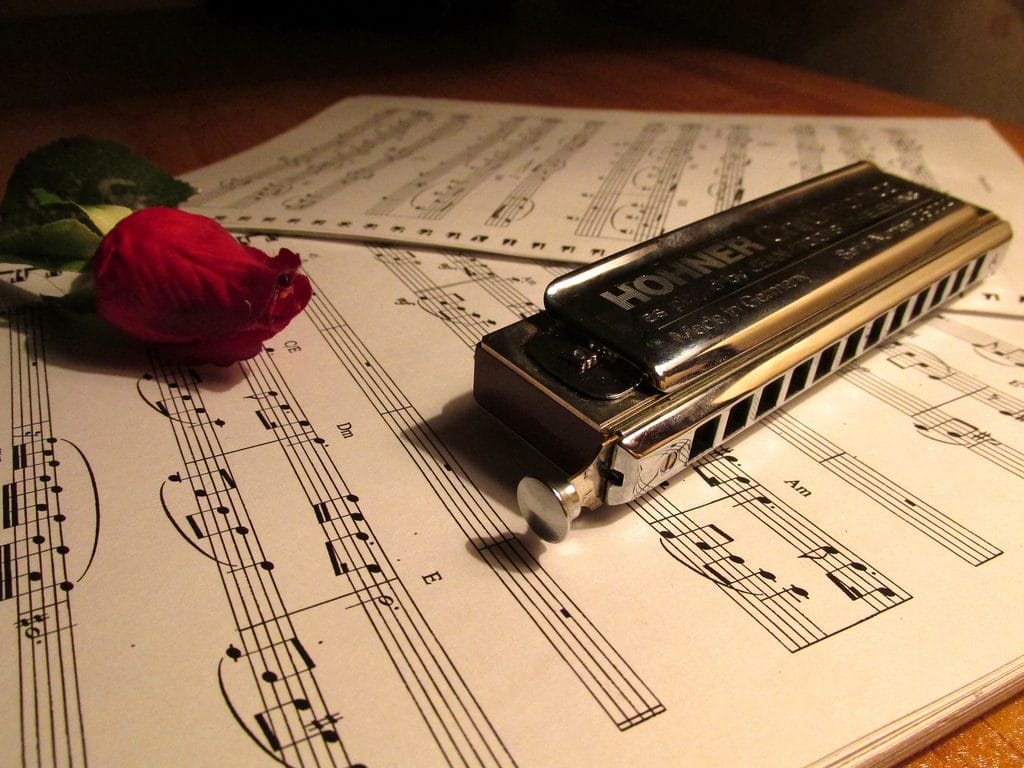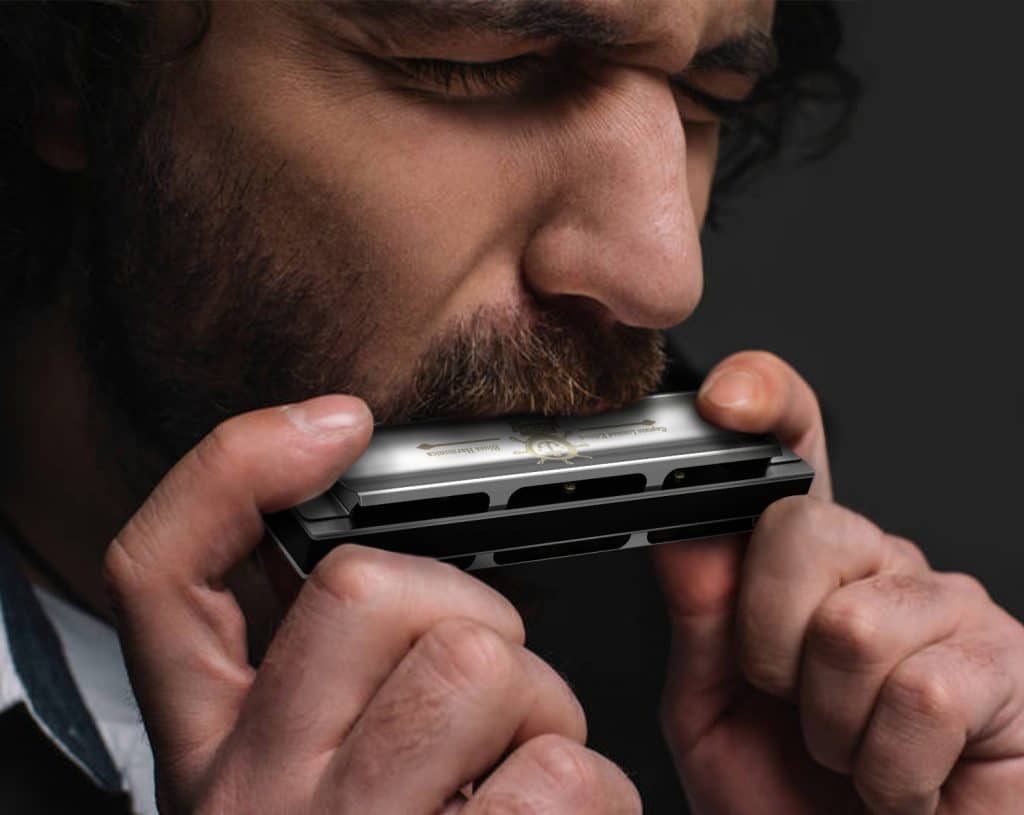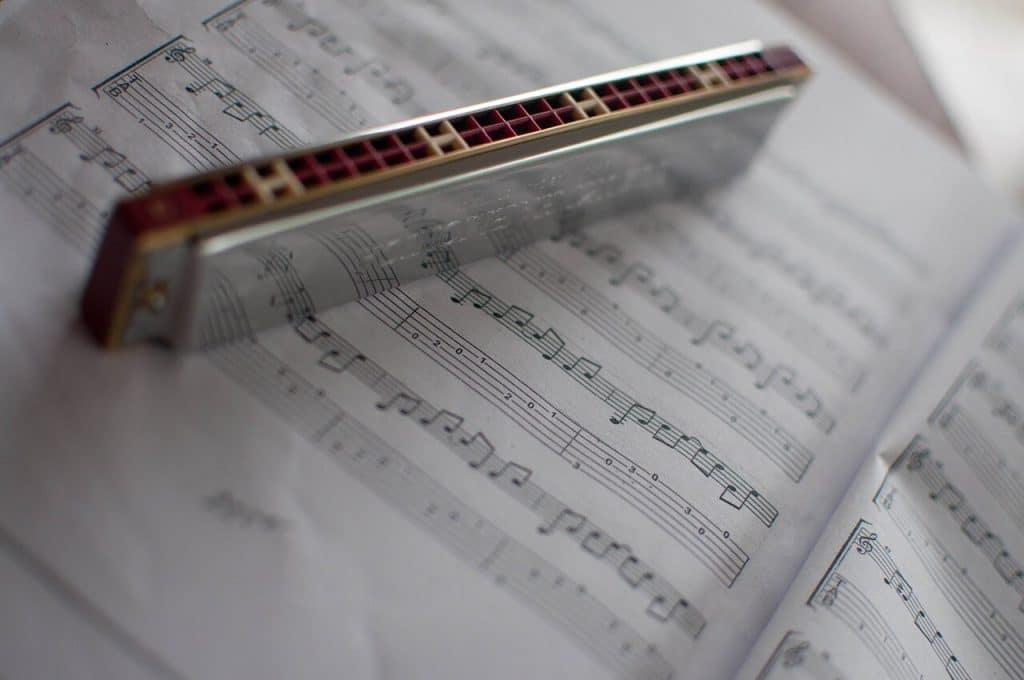The harmonica is a beautiful instrument that can add a lot of soul to any song. It’s also simple to play, making it great for those who haven’t learned an instrument or are looking to add another to their repertoire.
Here, we go through the steps of how to play harmonica with a detailed guide on the different types of harmonicas, learning the notes and the techniques. Once you’ve finished reading, you’ll be well on the way to becoming an accomplished harmonica player.

What many people don’t know is that there are a few different types of harmonica out there. Here, we will look at the differences between them.
Diatonic – This is the most common type of harmonica, and you’ll probably be starting with this one. There are 10 holes in which you can play both major and minor scales. You can also reach more notes using different mouth techniques.
Chromatic – These are more advanced harmonicas where you can amend the tone by pressing a button to move it up half a step. This offers a wider range of notes but will be hard to master, especially when bending notes.
Tremolo and Octave – These two types feature two rows of holes that can either create a tremolo effect or a fuller sound with the notes being an octave apart. These are much more niche and are rarely used.
Specialized – Some harmonicas have been specifically made for playing unique scales or scales that have more than one key. These are only used in specific circumstances and not something for beginners.
If you’re a beginner, you need to find a balance between quality and budget. You want a harmonica that will be easy and clear to play, but you also don’t want to break the bank by getting a model on the top end of the scale.
The best thing to do is to get a reasonably priced model from a reputable brand. Lee Oskar and Hohner both have brilliant harmonicas that are very reasonably priced. Hering, Suzuki, Huang, Bushman, and Seydel are also names that you can trust.
There are other great brands out there.
To play a note on a harmonica, you need to isolate a single hole. There are two ways of doing this you can either pucker your lips, as you would do with a kiss, or you can open your mouth wider and use your tongue to block the other open notes.
In terms of instruments, the harmonica has perhaps the easiest tablature. For one note, there will be a number and an arrow. The number indicates the hole on the harmonica you need to play, and the arrow will indicate whether it will be an inhale or exhale, with an upwards arrow used for blowing and a downward arrow for drawing your breath.
There are times when you’ll have a whole row of numbers (for example, 2,3,4,5) stacked on top of each other. For this, you need to play all of these holes, and again there will be an arrow indicating which type of breath you should take.
Sometimes, you’ll be asked to play the 2nd and 5th holes, for example. On a tab, the blocked 3rd and 4th holes will be represented by a black rectangle. Here, you would purse your lips around the holes and use your tongue to block the holes that aren’t required.
When bending a note down, there will be a slash on the arrow for each semitone the pitch needs to be changed by. If you need to overblow, then there will be a small circle on the arrow. If these terms are still confusing, they relate to playing techniques that we cover in the next section.

As we touched on before, there are two main ways of playing the harmonica. The pucker method is the one that you will probably start with, but in order to become a master of the harmonica, you will have to learn how to do both.
Pucker – Before playing the harmonica, it’s a good idea to relax and rest your lips on the instrument. When you inhale and exhale like this, you’ll find that you’ll be playing multiple notes at the same time, which isn’t always a bad thing.
When you’re thinking of how to play single notes on harmonica, you need to pucker your lips like if you’re just about to kiss someone.
It can take a little while to get this perfect, and you may find that you crossover with other notes at first or aren’t getting the warmth of sound. After a short while, it will get a lot easier, and you’ll soon be able to make one note sounds.
Tongue block – Another way to play single notes is to use your tongue to cover the other holes of the harmonica instead of puckering your lips. In this technique, you’d relax our mouth over the harmonica, ensuring a good seal.
In order to play a single note, you then block every hole to the right or left of the one that you intend to play. Again, this will take a bit of practice as you get used to how much pressure you need and the correct positioning to hit one note.
The tongue block playing technique is also used to split notes. This is where you block the middle notes while playing the two on either side. This is a more advanced way of playing, but you can soon get used to knowing how to bridge the middle two holes with your tongue.
Bending on the harmonica is a skill that is hard to master at first but is essential in becoming a brilliant player. Before trying to use the bending method, you should make sure that you’re completely comfortable with the basic techniques first.
It’s called bending as you are changing the shape of your mouth as you inhale or exhale. This is done to change the pitch of a note and is done a lot when playing the blues. There are a few types of bends, the most common being draw bends, but you can also play blow bends, overblows and overdraws.
Bending is hard to teach in the same way it’s difficult to teach someone to whistle. To make this easy, we’ll say what you should be doing and what result you’re looking for. You can do it by tilting the harmonica or not, and here, we’ll go through both methods.
To make the note bend, you must change the airflow angle over the reed inside the harmonica. You can do this by using mouth techniques, or you can simply change the angle of the harmonica, which we are looking at here.
To change the note, you need to tilt the back of the harmonica up to your nose. If playing a #4 draw note, for example, then you want to continue to draw that air through the harmonica in the same way with whichever playing technique you’re using.
When you do this, it’s very easy to let your head move with the tilting motion as you follow the harmonica. It’s vital to resist this, and it takes a little practice as you should keep your head and mouth in the same position as it was before.
Each hole that you use is going to require a slightly different angle of airflow to change the pitch by a step. You have to keep practicing and practicing it until you can comfortably start to control the bends and get the change of pitch you need.

Tilting is not the best long-term method for learning how to play the harmonica. With having to tilt the instrument constantly, you are limited in the number of songs you can play as it’s not an effective way of playing if you keep waving the harmonica up and down. Tilting gives you a great basis to get to the next bending stage.
To do this, you need to create a steep angle of airflow in your mouth. Your jaw and tongue play a huge part in this to create the pathway. You start by moving your lower jaw forward but only by a fraction to give your tongue more space and pressure.
Following this, it’s easiest to press your tongue against the roof of your mouth and, at the same time, press the tip of your tongue into the back of your teeth. You’ll notice that this blocks the airflow into your mouth.
What you need to do is lower your tongue slightly so that it’s just under the roof of your mouth. You’ll now notice that you’ve created a narrow pathway of airflow, and this is what you need to be able to bend your note.
Your harmonica will be in one key, and the first position on that harmonica will be an anchor of that key. When you learn how to play harmonica C, you’ll get the note from blowing on holes 1, 4, or 7, and this will be your first position.
You can still play different keys on the same harmonica, which involves moving up from your root position. On a C harmonica, each position change would change the key with 2nd being G, 3rd being D, 4th – A, and 5th – E. This will change if you have a harmonica in a different key.
The 2nd position on a C harmonica would mean starting with a G note, which would be done on the 2 draw or 6 blow. The 3rd position, a D note, would be a 1, 4, or 8 draw.
Changing positions allows you to play different scales, which is quite useful when it comes to how to play harmonica songs. 1st position is commonly used for melodies in the major key, which is used in many different types of music from country songs to blues.
The 2nd position is also used to play melodies in the major key, but it can also let you play tunes with a flat 7th and major notes where you can go below the home note. You can also play all scales of blues from this position.
If you wanted to play minor key melodies, then you would want to do this from the 3rd position onwards. It’s great for playing minor blues and also some fiddle tunes that are played in Dorian mode.
As you move to the 4th and 5th position, this will allow you to play more minor keys. You can technically play in 12 different positions, but in reality, you won’t use anything beyond the 5th position.

It will be the best practice to start with a C harmonica and then work your way from there. Once you get comfortable with playing, and you have practiced your techniques, then it’s a good idea to get harmonicas in different keys.
You want to be able to walk before you can run. Start with a C, then perhaps move to a D or a G next. Once you become an expert, then you could move on to how to play a chromatic harmonica or even try tremolo or octave models.
You want to be able to clean your harmonica every now and again. You’re constantly placing your lips on this instrument and blowing through it, and, therefore, you don’t want it to harbor germs. It’s a good idea to regularly wipe the outside of the harmonica to keep it clean.
You will need to clean the inside of the harmonica at times, and the way to do this will depend on the type of model you have. The middle section is called a comb. If this is made from plastic, then you can run warm water through it and then simply allow it to air dry.
For more thorough cleaning, and for wooden or metal combs, you’ll need to disassemble the harmonica. This will be very easy to do as it will just be screwed together. Once separated, you can clean the comb using soap, warm water, and an old toothbrush if required.
The reeds on either side of the comb can be just be cleaned with soapy water. Once cleaned, rinse with clean water and dry them straight away. Wooden and metal combs need to be completely dry before you reassemble as water can ruin the wooden comb, or the metal can rust.
A harmonica is a simple yet elegant instrument that has been featured in many great songs from the likes of Love Me Do by The Beatles and She Lovely by Stevie Wonder to more folk and blues songs such as Mr. Tambourine Man by Bob Dylan and Carolina Blues by Blues Traveler. The list of brilliant songs that include harmonica is vast.
This instrument is soulful and powerful. Thankfully, learning how to play harmonica is not too difficult, but it can take a while to perfect the playing techniques. Make sure you keep practicing and don’t lose heart if it takes a while because you will get there eventually.